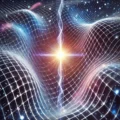Solar Eclipse Light Deflection (1919)
Standard Interpretation
Purpose:
To test Einstein’s prediction from General Relativity that light is deflected by gravity, specifically as it passes near a massive body like the Sun.
Method:
Photographs of stars near the Sun were taken during a total solar eclipse. The apparent positions of these stars were compared to their positions when the Sun was not in the same field of view (i.e., night sky observations).
Result:
- Stars appeared slightly displaced away from the Sun, consistent with Einstein’s predicted deflection:
![]()
where: θ = angular deflection of starlight (in radians). G = gravitational constant, M = mass of the deflecting body (e.g., the Sun), c = speed of light in vacuum, b = impact parameter (closest approach distance to mass).
- The amount of bending was twice what Newtonian gravity predicted, confirming Einstein’s theory.
Conventional Conclusion:
The results supported General Relativity’s view that space-time is curved by mass-energy, and that light follows this curvature, appearing to bend around massive objects.
Charge Admittance (CA) Reinterpretation
CA Principles Relevant Here:
- Energy in Mass Alters Lattice Response – Bound energy in mass distorts local charge lattice admittance.
- Gradient in Lattice Impedance Guides EM Propagation – Light travels not in “straight lines” through space, but along minima in admittance gradients, akin to refraction.
- Deflection is a Lattice-Optical Effect – Light bending emerges from a refractive-like interaction with a structured medium whose impedance varies with energy density.
CA interpretation:
- Why Light Appears to Bend:
- The Sun’s energy alters the surrounding lattice impedance, forming a gradient in the effective refractive index.
- EM waves follow paths of least impedance delay, bending similarly to light in a gradient-index optical fiber.
- The observed deflection is not due to space-time curvature but to anisotropic propagation speeds induced by the energy field around the Sun.
- The bending magnitude matches GR because both frameworks describe the same empirical gradient, but CA attributes it to material dynamics, not geometry.
- Analogy:
- Think of the Sun as creating a radially varying dielectric medium—light curves the way it would near a glass lens, not because space is curved, but because the vacuum’s properties are modulated by energy.
How CA Challenges or Extends GR View
- Challenges:
- Discards the need for geometric curvature of space-time.
- Replaces geodesic deviation with impedance-guided wave propagation in a structured vacuum.
- Validates/Extends:
- Retains the quantitative prediction: deflection angle δθ = 4GM/c2b
- Opens up testable implications for non-gravitational lensing effects, such as light bending near high-field or energy-dense electromagnetic systems.
Implications for Further Research
- Experimental Predictions:
- Artificially engineered lattice impedance gradients (e.g., using EM field configurations or Casimir cavities) may reproduce similar bending effects on light.
- In high-energy astrophysical environments (e.g., magnetars), CA predicts additional or differential bending beyond GR due to non-gravitational admittance variation.
- Observational Consequences:
- Deviations in lensing patterns (e.g., weak lensing maps of galaxy clusters) could signal CA-specific lattice effects, especially where mass-energy distributions are asymmetric.
- Suggests possibility of tunable lensing in lab-scale experiments by manipulating local vacuum conditions—offering a radically new form of vacuum optics.
